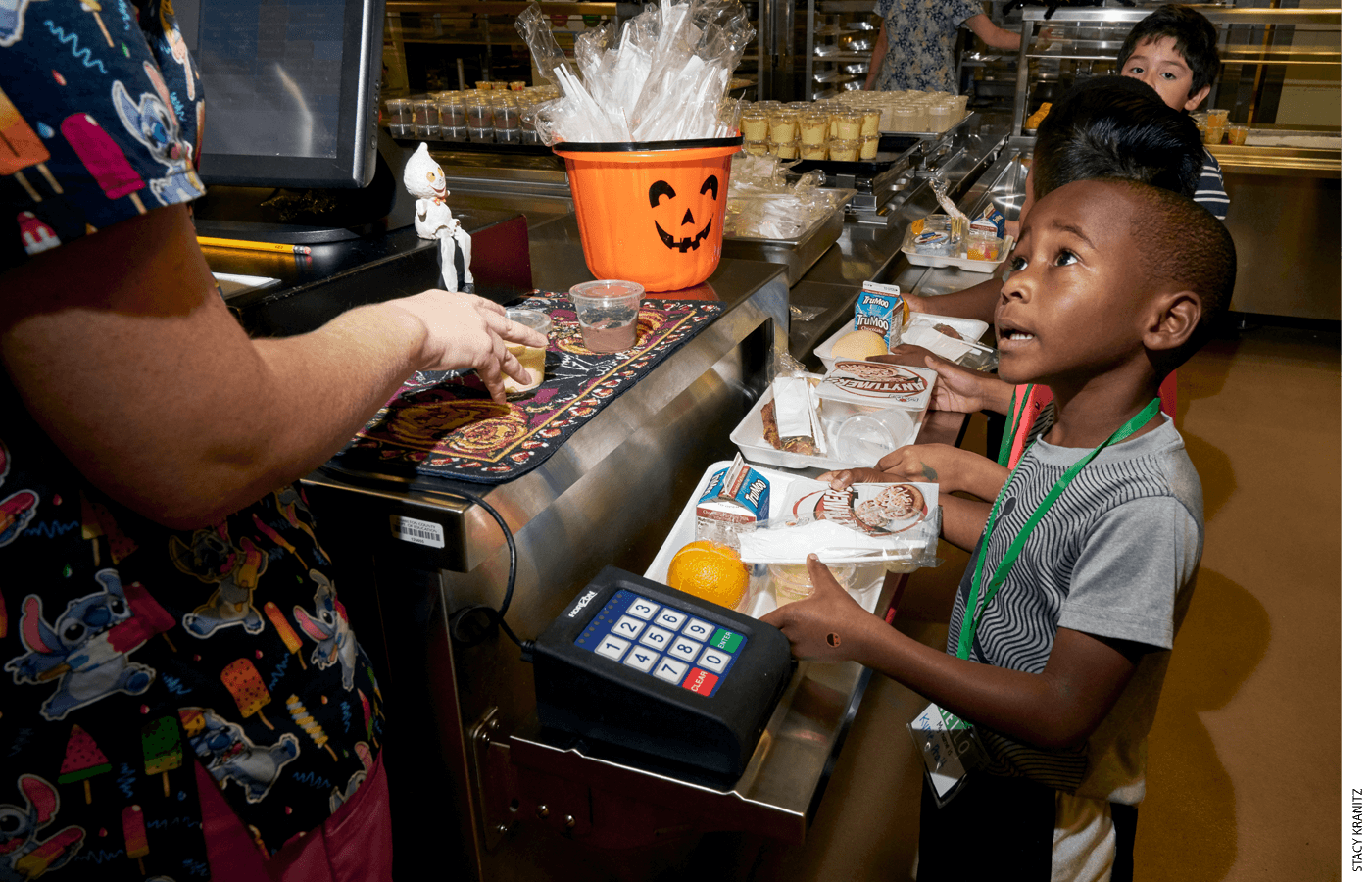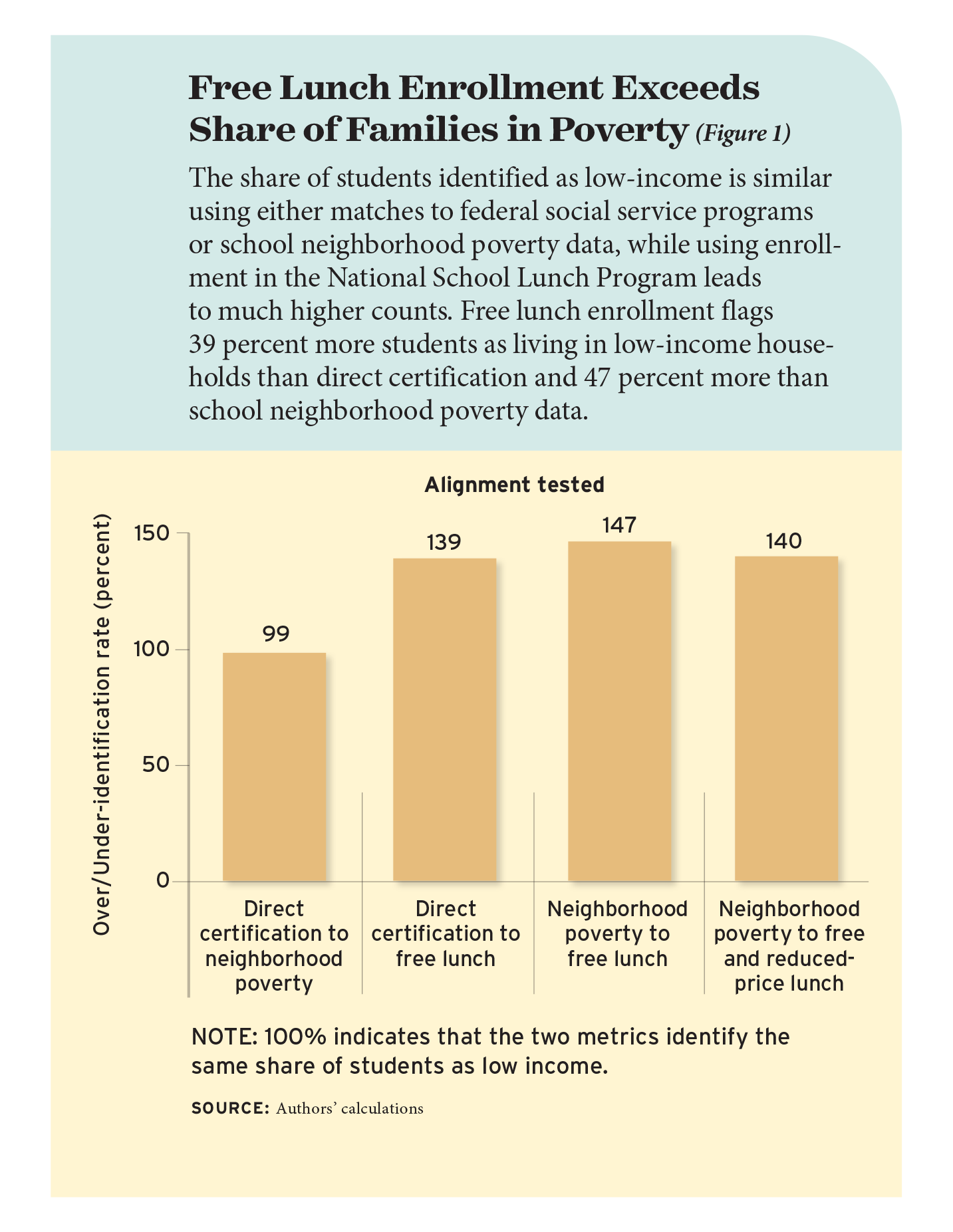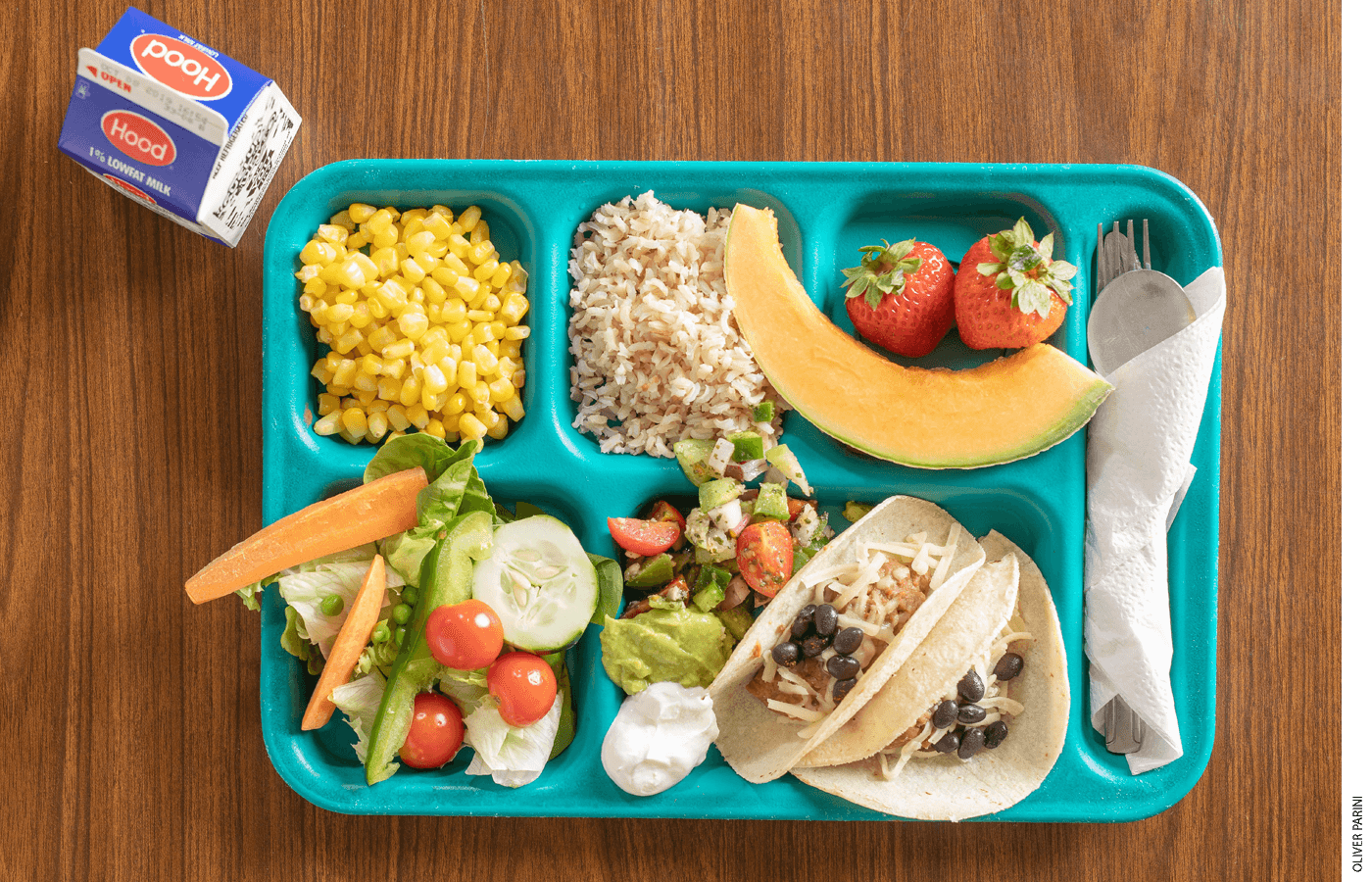
In education policy and public debate, we often talk about students from “low-income” families. That descriptor is typically based on data from the National School Lunch Program, which provides qualified students with school meals for free or at a reduced price. Enrollment in the program, which is operated by the U.S. Department of Agriculture, plays a central role in identifying low-income students in U.S. schools and thus a central role in consequential education funding and accountability policies at the federal, state, and local levels.
For example, the federal Every Student Succeeds Act requires states to track gaps in student achievement by poverty status. Among the 50 states, 44 use free and reduced-price lunch enrollment to identify low-income students. These data are also commonly used to allocate federal, state, and local funding to schools serving low-income children. School and district poverty rates, as determined by free and reduced-price lunch enrollment, additionally feature prominently in social science research, school-funding lawsuits, state laws and regulations, and philanthropic investment.
Yet a close look shows that free and reduced-price meal designations in the National School Lunch Program are grossly inaccurate indicators of family income. Using administrative data from Missouri, we find that student enrollment in the program is oversubscribed by about 40 to 50 percent relative to stated income-eligibility rules. This finding is not unique to Missouri. We see the same basic pattern in an extended sample of 27 states. Moreover, this is not a recent phenomenon. Enrollment in the school lunch program was oversubscribed even before 2014–15 when the “Community Eligibility Provision” was rolled out nationally, which permits sufficiently high-poverty schools and districts to enroll all their students to receive free meals.
While it has been understood for some time that school lunch enrollment as a poverty indicator is blunt and prone to error, the magnitude of the problem has not yet been fully appreciated. In exploring the rules, features, and processes of the National School Lunch Program, we find that the program’s design, incentives, and lack of income-verification enforcement likely contribute to the oversubscription. These findings raise important questions about the administration of a program that supports the nutrition of American schoolchildren as well as key datasets driving policy and funding decisions across the country.
More Than Just Lunch
For three quarters of a century, schoolchildren from low-income families have received low- or no-cost meals under the National School Lunch Program. In 2019–20, the program provided subsidized lunches to nearly 22 million students at about 94,000 public and nonprofit private schools across the United States.
Students are enrolled in the program in two ways. Through direct certification, students are automatically enrolled for free school meals if their families receive benefits such as food assistance, Medicaid, and Temporary Assistance for Needy Families, or if they are migrant, in foster care, or homeless. Alternately, school districts administer income surveys to parents to determine eligibility. Students from families with incomes at or below 130 percent of the federal poverty line qualify for free meals, and those from families with incomes between 130 and 185 percent of the poverty line qualify for reduced-priced meals. State and federal aid programs like Medicaid and food stamps verify incomes reported by participants, while school districts usually do not. In addition, if an attempt to verify eligibility fails, a student’s enrollment in the lunch program ends, but there are no other repercussions.
Enrollment in the school lunch program is a commonly used proxy for student poverty in policy, research, and for other purposes. But is it an accurate indicator of family income? To answer this question, we analyze school meal enrollment and two alternative measures of poverty in Missouri schools during the 2016–17 school year to determine how closely they are aligned. Our data on meal enrollment are from the state education department and show students’ National School Lunch Program designations. Each student is coded as enrolled for free meals, reduced-price meals, or neither. Our alternative poverty measures are based on students’ direct certification data and estimates of school-neighborhood poverty from the National Center for Education Statistics, which are based on the incomes of households located near schools as reported in the Census Bureau’s American Community Survey.
Assessing Accuracy
A case could be made for using either direct certification or school neighborhood poverty data for the purpose of assessing the accuracy of students’ meal designations. In Missouri, direct certification applies to students from families living at or below 130 percent of the poverty line, which is the same income threshold for free-meal enrollment by the National School Lunch Program. And while school-neighborhood poverty estimates are reported as the average family income associated with a school, with some basic adjustments they also can be used to estimate the share of students living at or below 130 percent of the poverty line.
However, there is no guarantee that either alternative metric is itself accurate. Therefore, in a two-way comparison of free lunch data to either direct certification or school neighborhood poverty data, it would be difficult to know the source of any discrepancy. Given this, we first compare the two alternative data sources to each other. When we do this, we find that the estimated shares of students in a school living at or below 130 percent of the poverty line are very closely aligned, which gives us confidence that both alternative measures are accurate, on average.
We then conduct similar tests to assess the accuracy of the shares of students who receive free or reduced-price lunch. That is, we test whether the school lunch program enrollment share in a school matches the share of students living at or below 130 percent of the poverty line (free) or 185 percent of the poverty line (free and reduced price) as measured by the direct certification and school neighborhood poverty data. If schools and districts are following the National School Lunch Program rules, these numbers should line up.
This is not what we find. We conduct a series of alignment tests where a value of 1.0 indicates one-to-one correspondence; that is, 1.0 means the poverty data from the measures being compared match each other across Missouri schools, on average. While the direct certification and school neighborhood poverty measures are aligned with each other, neither of them lines up with free or reduced-price lunch enrollment (see Figure 1). Compared to direct certification, free lunch enrollment flags 39 percent more children in a school as living in households with incomes at or below 130 percent of the poverty line, on average. Similarly, compared with school neighborhood poverty, 47 percent more children are flagged as living in households with incomes at or below 130 percent of the poverty line in the free lunch data.
We then assess alignment at the free-and-reduced-price enrollment threshold of 185 percent of the poverty line. Unfortunately, we cannot conduct the alignment test at this threshold using direct certification data because that threshold is 130 percent in Missouri. However, we can use the school neighborhood poverty data, which show that enrollment for free and reduced-price meals is also substantially oversubscribed, by about 40 percent.
Next, we explore how the Community Eligibility Provision figures into our findings. This provision, which was included in the 2010 reauthorization of the program and was rolled out nationally during the 2014–15 school year, subsidizes free meals for every student at participating schools and districts. To be eligible, a school or district must have at least 40 percent of students qualify for direct certification. For districts and schools in Missouri (and many other states) that adopt community eligibility, all of their students are reported as being enrolled for free meals. Community eligibility for free meals will certainly contribute to our finding that the poverty rate is overstated by data from the National School Lunch Program, but the magnitude of the effect is unclear.
To disentangle the effect of the Community Eligibility Provision, we incorporate data from the 2013–14 school year, just before the provision was implemented. Specifically, for schools that adopted community eligibility in our data from 2016–17, we use their free and reduced-price meal enrollment rates to the 2013–14 values. We leave the enrollment rates for non-participating schools unchanged. This exercise shows that while the Community Eligibility Provision has contributed to oversubscription in the free lunch category in recent years—as expected—it is not the primary driver. The provision explains 15 percentage points of the free lunch oversubscription and 9 percentage points of the free-or-reduced-price-lunch oversubscription in our data, or about one third to one fourth of the total oversubscription rates. The implication is that even before the Community Eligibility Provision, enrollment was greatly inflated relative to the National School Lunch Program’s stated income thresholds.
Finally, we consider school lunch and neighborhood poverty data from a larger 27-state sample to show that our findings are not unique to Missouri. This exercise involves different datasets and some additional assumptions, the details of which we provide in another publication. Suffice it to say here that the average oversubscription rates in this larger sample are close to the rates in Missouri. We conclude that the oversubscription of free and reduced-price lunch is likely endemic in the United States.

Why Is Enrollment Oversubscribed?
The degree to which enrollment in the National School Lunch Program is oversubscribed is not well understood—but perhaps it should not be surprising. Outside of direct certification, free and reduced-price lunch enrollment is based on mostly unverified surveys. These are administered by school districts to parents, and both groups have incentives that encourage oversubscription.
Districts may be motivated by concerns about child welfare and academic performance; healthy, ample lunches during school contribute to both. But districts also may be incentivized to encourage and approve parent applications in order to gain access to additional federal, state, and local funding to support low-income students. Meanwhile, parents are incentivized to enroll their children because participation lowers their food costs.
In addition, the United States Department of Agriculture does not seem particularly interested in enforcing income eligibility rules. As noted by David N. Bass, only a very small number of applications go through an income-verification process (see “Fraud in the Lunchroom,” feature, Winter 2010). In fact, according to the department’s Eligibility Manual for School Meals in 2017, attempting to verify more than 3 percent of applications without special cause is prohibited. When eligibility is checked and cannot be verified, the student’s meal subsidies are discontinued, but there are no other consequences. The incentive structure clearly favors districts and parents stretching the boundaries of eligibility.
We do not want to go too far down the path of wondering why the federal agriculture department does not enforce its income-eligibility policies more strictly, much less whether it should. The most obvious explanation is that lax enforcement is a strategy to increase meal access for students in public schools, especially considering other initiatives to promote broader access to subsidized school meals, like community eligibility. This may be an appropriate approach to policy implementation given evidence that children benefit from expanded access to free and subsidized meals.
However, this highlights a fundamental problem with using these data to inform other consequential education policies: enrollment for free or reduced-price school lunch is not a reliable measure of family income. Rather, it is a measure that can be, and seemingly is, manipulated by administrators to promote their own objectives related to meal access and program participation. The end result is that school lunch data are a poor proxy for student poverty counts. The problem is not with the National School Lunch Program’s administration of its own program, but rather the education system’s reliance on enrollment data to achieve objectives for which the program and data were never designed—and are not maintained—to support.

A Policy Problem
The use of data from the National School Lunch Program in consequential education policies is ubiquitous. The most prominent example is in state funding formulas, which use free and reduced-price lunch enrollment as the basis for distributing billions of dollars to school districts every year. While states’ allocations of federal Title I aid to support low-income students are based on Census data, not National School Lunch Program data, school lunch data can affect the allocation of federal aid within states and school districts. State accountability policies that track achievement gaps by poverty status also commonly use free and reduced-price lunch enrollment to identify students in the “low-income” group.
The substance and scope of these policies suggest that the consequences of inaccurate school lunch data are significant. For example, consider a funding formula designed to allocate resources to students living at or below 185 percent of the poverty line. If oversubscribed school lunch data are used to proxy for this condition, our estimates from Missouri indicate that the number of students identified as low-income would be overstated by about 40 percent. If the resources to support low-income students are from a fixed budget set aside to support the true target population, the inflated count due to oversubscription would greatly dilute the resources available for each targeted pupil. And that would shift funding away from the most severely disadvantaged students.
Our findings support the position that the education system should move away from relying on National School Lunch Program meal designations as consequential measures of income status. In addition to showing that lunch program participation is greatly oversubscribed, we also note the possibility of substantial variation in oversubscription among school districts. This can lead to a situation where districts receive funding support that is more related to their success in soliciting applications that show eligibility rather than the actual number of low-income families they serve. To the extent that this variation exists, school districts that are more aggressive in signing up students or where parents are more engaged in the application process stand to gain more than districts that are less aggressive, even when their underlying levels of true poverty are the same.
Where do we go from here? Consternation among policymakers caused by the Community Eligibility Provision has led some states to change from using school lunch data to using direct certification data to count low-income students. Our findings in Missouri suggest this shift improves accuracy. However, a caveat to this result is that different states implement federal social-assistance programs differently, and those particularities make it difficult to project how broadly our findings will generalize outside of Missouri. The primary concern is how state policies differ regarding eligibility for food assistance through the Supplemental Nutrition Assistance Program, the primary program that leads to direct certification. Some states allow families with incomes of up to 200 percent of the poverty line to qualify for the program through Broad Based Categorical Eligibility. Missouri is one of a handful of states that does not have Broad Based Categorical Eligibility.
Variation across states in their policies regarding Broad Based Categorical Eligibility has two implications for poverty measurement using direct certification data. First, it means that direct certification status conveys different information about the level of poverty in different states. This has implications both for individual state policies and federal policies that affect multiple states. Second, it is unclear whether direct certification status will accurately measure the income thresholds intended by state rules, given differences among states in program participation and how income rules are enforced. For example, in some states, participation in Medicaid can lead to direct certification, but research shows that many Medicaid-eligible families do not participate in Medicaid. Concerns have also been raised about the fidelity with which Broad Based Categorical Eligibility criteria are enforced.
A larger conceptual concern is that income metrics based on direct certification share a critical flaw with metrics based on free and reduced-price lunch: they are not policy invariant. Like with data from the National School Lunch Program, the criteria that determine direct certification status are subject to continued change as policymakers target evolving policy objectives outside of the education system, not accurate poverty measurement.
Looking Ahead
Despite these concerns, direct certification data are likely the most feasible alternative to school lunch data to identify low-income students and implement education policies to support those students—at least in the short run. Over a longer horizon, we hope for more comprehensive solutions. One aspirational alternative would be to merge education data with tax data from the Internal Revenue Service, state tax agencies, or both, which could capture family income more accurately. This merge is technically feasible, and proof of concept has been established by recent research and at least one state policy. However, to adopt this as common practice would require overcoming political barriers and establishing new avenues of data sharing between agencies in most states.
In the more immediate term, it is worth considering policies that lessen the emphasis on flawed measures of family income in favor of broader indicators of student need. For instance, we could develop generalized measures of student disadvantage to inform education funding and accountability policies. Such measures could incorporate imperfect information on poverty from subsidized meal data and direct certification data but also include information about geographic mobility, attendance patterns, test and other school performance measures, and participation in remedial programs, among other factors. By considering these many facets of disadvantage together, we can improve measurement and expand our understanding of the broad range of need among students.
Ishtiaque Fazlul is a clinical assistant professor at Kennesaw State University. Cory Koedel is a professor at the University of Missouri, where Eric Parsons is an associate teaching professor.
This article appeared in the Spring 2023 issue of Education Next. Suggested citation format:
Fazlul, I., Koedel, C., and Parsons, E. (2023). A Poor Poverty Measure: To identify children in need, look beyond free lunch data. Education Next, 23(2), 48-53.


